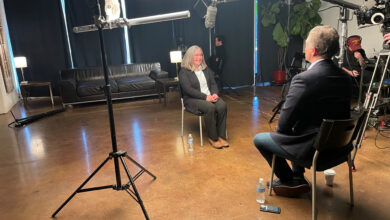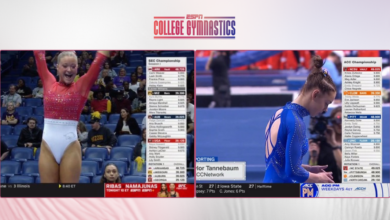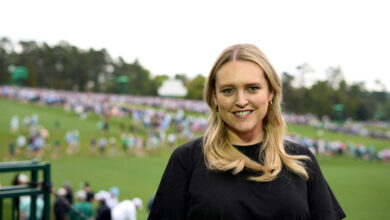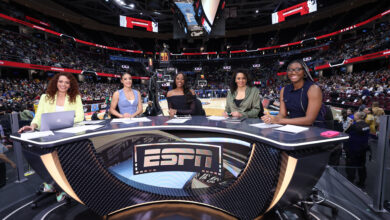As The NBA Bounces Back To Action This Week, ESPN Is In Lockstep With Innovative Coverage
SVP, ESPN & ABC Sports Remote Production Operations, Chris Calcinari, shares the vast scope of his team’s efforts to bring live sports back to fans while taking all precautions
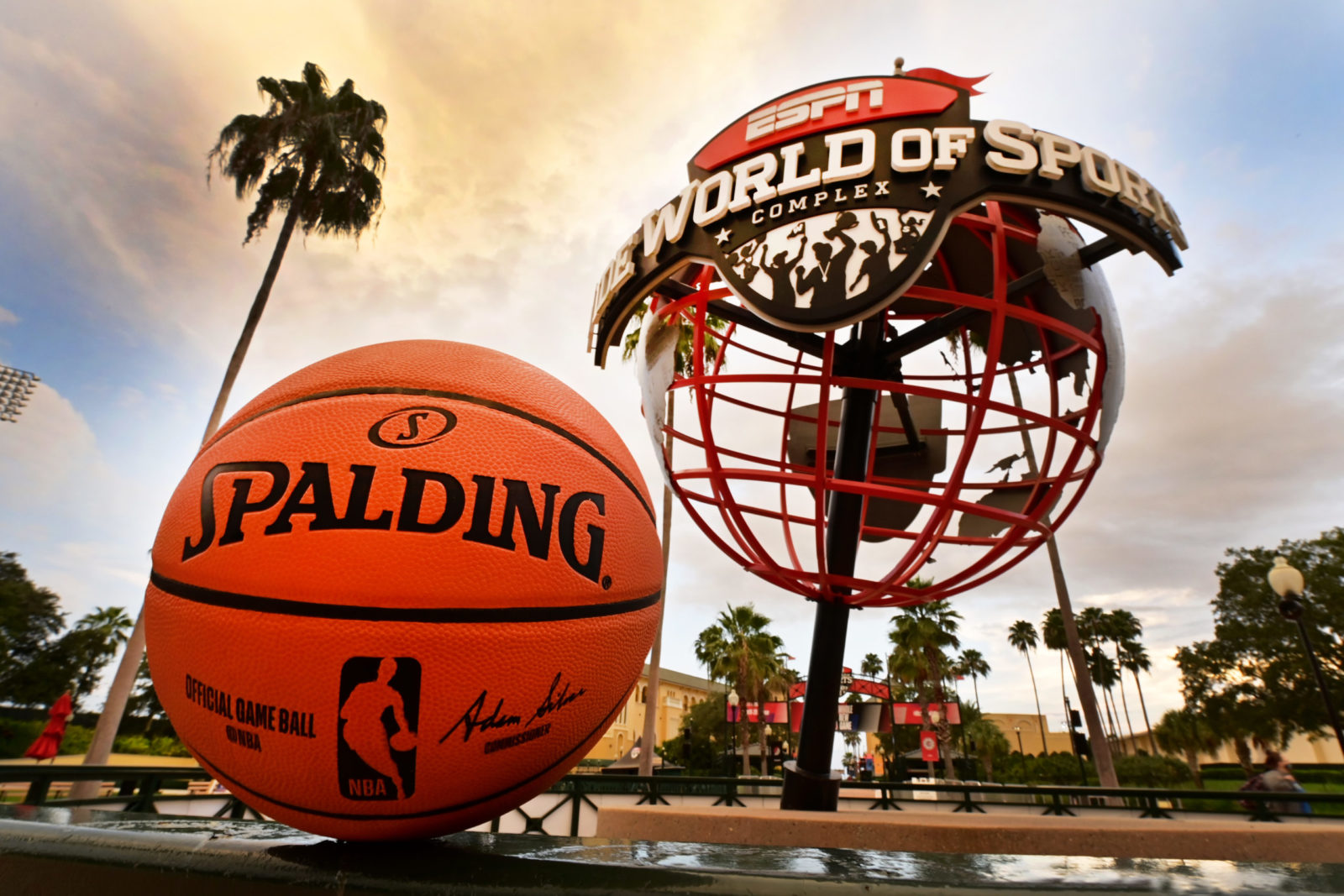
(Phil Ellsworth/ESPN Images)
Since mid-March, when sports were placed on hold, and work-at-home mandates were the norm, ESPN’s Remote Operations team moved at warp speed, creating new workflows and ingenious solutions to keep ESPN’s programming on the air while keeping employees safe.
From home studios for commentators to producing entire shows from home, the team has continuously generated practical ideas and solutions. With a variety of sports now returning, the team has the added focus of employees being on-site at multiple locations. Senior Vice President, ESPN & ABC Sports Remote Production Operations, Chris Calcinari, shares the vast scope of his team’s efforts.
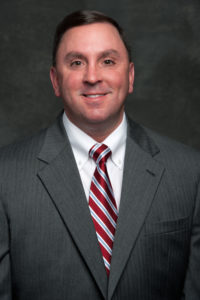
What are your goals and expectations now that sports are returning?
Our main goal is to provide a safe environment for everyone working on site. It’s really important that everyone has confidence in their work environment so that they can be comfortable and focus on their jobs.
We just completed seven straight weeks of boxing, are halfway through the MLS tournament; and MLB, WNBA, and NBA now have staff on-site. We are just beginning to set up for the PGA Championship and US Open as well. There is now a large number of people working in the field, and so far, our safety practices are working well.
I can’t stress enough how lucky we are to have incredible partners on the Safety, Security, Human Resources, and Legal teams. We have been engaged with these teams for months and literally focus on this important aspect of our operations throughout each day.
What protocols are in place to keep our employees safe?
The key protocols are similar to how everyone is living, in general, these days: wearing masks, social distancing, washing hands, and not touching your face. In addition, we have several added layers on-site, including assigned seating in mobile units and workspaces/zones that ensures proper distancing and keep people in specific working areas; improved air filtration, deep cleaning of all work surfaces and equipment, packaged and/or plated catering, proper transportation to/from hotels/site and much more.
Each league and organizing body also has specific parameters in place around testing, quarantining, and – in some cases – living in a total bubble-type environment. We are working closely with each of them and taking advantage of any opportunities that they present to add additional layers of safety for our teams.
Yes, our various teams have done an incredible job creating innovative solutions that not only allow people to work from a distance, but that maintain a high degree of quality. – SVP, ESPN & ABC Sports Remote Production Operations, Chris Calcinari
Your team has provided some ingenious and creative solutions to keep shows on the air since the pandemic started. What are some that will be used as sports return, and what are the key enhancements being implemented?
Yes, our various teams have done an incredible job creating innovative solutions that not only allow people to work from a distance, but that maintain a high degree of quality.
These include our various Live from Home tools such as the home studios that have enabled our talent to contribute to our various shows and events from the safety of their homes; the home commentary systems that provide talent with the proper audio, on-camera and monitoring (to see the program feed, stats and each other) tools to call games or host shows from home; as well as a full suite of production tools that allow directors, producers, and technicians to produce full shows from home.
All of these tools will remain available to us as we move forward and think about how best to execute our shows and events in this new environment. In terms of key event innovations and enhancements, I would point to the following so far:
- Boxing: The Hear Me Cheer App/Technology has allowed fans to cheer from home through their phones or computers. This audio has been mixed into our Top Rank Boxing productions. Home studios and commentary systems have supported talent calling the fights from home.
- MLS: We have enhanced our audio through microphones buried in the field, deployed around the benches, on the referees and through traditional shotgun and parabolic mics. Camera enhancements have included four-point aerial cameras called Omnicam that cover the action from above the field, as well as drones, a jib on a cart that can move up and down the field as required, pole cams with miniature super slo-mo cameras, cameras embedded within the frame of the goals and more. Virtual graphics and field boards that leverage camera technology to display different video outputs (for US and International distributions) are being utilized to support Sales requirements.
- MLB: We are using many of the enhancements that our Sunday Night Baseball viewers have become accustomed to, including dirt mics embedded in the grass to capture sound from the field, K-Zone, and super slo-mo cameras. Home studios and commentary systems will support talent calling games from home.
- NBA Similar to MLS, we will be enhancing our audio with microphones embedded in the floor and deployed around the benches, court, and backboards. Camera enhancements will include rail cameras that will glide along the court at floor level, a significant amount of robotics deployed on top of, behind and below the backboards, in locker rooms, hallways, and at practice facilities.
Drones will be used outside to capture scenics. Virtual graphics will be used to support ESPN Ad Sales.

An aerial view of the NBA production compound at ESPN Wide World of Sports. (Photo courtesy of Chris Calcinari/ESPN) The scale of the NBA operation is significant, as shown in the picture above. ESPN has led the overall design and build-out of the compound and technical infrastructure. Highlights include:
-
·Broadcast Compound Size = 194,920 square feet (roughly three football fields)
·Mobile Units = 13
·Number of Cameras = 258 (includes 60+ robos)
·Number of Microphones = 357 (across 3 courts)
·Miles of Fiber = 436+ miles of cable
·Generators = 20 (12 x 500kVA units, 2 x 300kVA, 2 x 400kVA Tow Plants, 4 x 175kVA Tow Plants)
·Trailers/Tents = 31 Trailers, 6 Mobile Unit Cover Tents, 2 Catering Tents, 2 Field Shop Tents, Multiple Cooling Stations
·Added HVAC Units = 32 x 20+ Tons
·Transmission Paths = 65 Outbound Transmission Paths, 14 Inbound Return PathsNFL and college football are clearly our next biggest challenge. Because of the significant volume of games and associated resources involved, we are working with our Production colleagues to operate as smartly as we can in this environment. Many of the tools that are mentioned above will be in play as we look to finalize our strategy.
– Calcinari
With multiple colleagues working remotely for live sports and studio show production, how have you kept everything running smoothly?
We have worn out Zoom and Blue Jeans! Seriously, we have an incredible team that is working around the clock, and we thank them for their hard work and dedication. With a dispersed workforce, thorough planning and increased communication are essential.What’s next?
NFL and college football are clearly our next biggest challenge. Because of the significant volume of games and associated resources involved, we are working with our Production colleagues to operate as smartly as we can in this environment. Many of the tools that are mentioned above will be in play as we look to finalize our strategy.https://www.youtube.com/watch?v=ft5Nk0sJyTY
